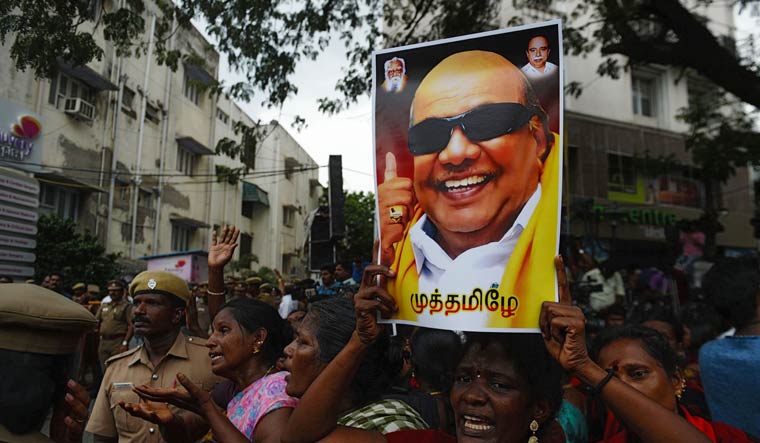In 1916-17, when the Dravidian movement took form, it was largely against the hegemony of Brahmins. It was around the mid 20s that it occupied a much bigger and expansive political space, with Periyar E.V. Ramasamy launching the Self Respect movement in 1925. For the next 10 years, it was more a protest against the Brahmin hegemony, with an Aryan-Dravidian oppressor-liberator binary. This pervaded the cultural and political spheres. The real start of the Dravidian political movement was the anti-Hindi agitation of the 1930s; Karunanidhi entered the fray then.
In the 1940s, the Dravidar Kazhagam [Periyar and C.N. Annadurai being two of its well-known leaders] came into existence. In the mid-1940s, there started demands for a separate Dravida Nadu [Dravida nation]. In 1947, during the transfer of power from Britain to the India, Periyar called it a black day, that the administrators had just changed from the British to the north Indian upper castes. One thing we all should take note. Many have often equated the anti-Brahmin movement to violent ideologies like the Nazi. Nothing could be farther from the truth. It was a social, political and cultural movement. No Brahmins were harmed then. Annadurai wanted a much bigger political space and the DMK was launched in 1949. In the 1950s and 1960s, the Dravida Nadu movement was relegated to the backstage, after the states were formed on a linguistic basis. Then, the movement shifted to one for state autonomy. DMK, who refused to ally with the Congress, won in 1967, but Annadurai died just two years later, in 1969. The search for a new leader began and Karunanidhi took up the helm. The following years, right until Emergency was declared, were golden years for the DMK. Under Karunanidhi, a lot of new programmes, social schemes and political programmes were launched. Moreover, he continued with the mission for state autonomy, and constituted the Rajamannar committee [in 1969] to study the constitutional minutiae of Centre-state relations. To date, it is one of the finest reports on federalism in post-independent India.
Karunanidhi's impact on Tamil Nadu can largely be divided into two phases: Till the Emergency and afterwards. It was in the first phase that he made 80 per cent of his contributions to Tamil society. During Emergency, when almost every state government stood with Indira Gandhi, Karunanidhi was very much against it. After Emergency though, it is a different story. In the 80s, there came a dilution in his political stance and worldviews, and he even aligned with the Congress, the party which he once rallied against as a 'North Indian, Brahmin' party. In the last 15 years, family politics has led to him losing ground. He did not respond the way he should have had when the 2009 Eelam genocide happened. That was a let down for many Tamil people. He simply succumbed to the Congress pressure. Or take his response to the death of Prabhakaran [LTTE founder]. The political career of his sons and daughters took precedence for him, and not the Sri Lanka issue.
But, if Tamil Nadu is leading now in social, economic and political indicators, a lot of credit goes to Karunanidhi. He was an able administrator, and his love for the Tamil language was apparent in the way he patronised texts like the Tirukkural.
Aazhi Senthilnathan is a veteran journalist.
(As told to Vaisakh E.Hari)


